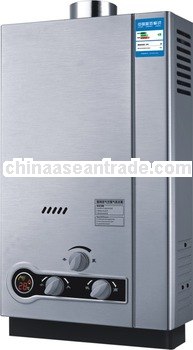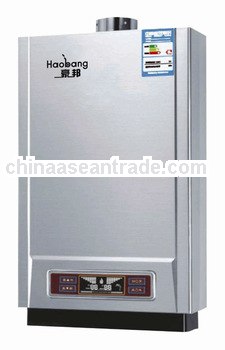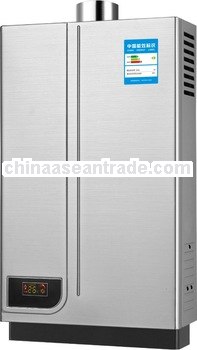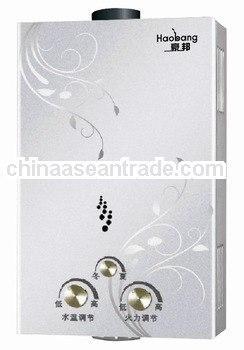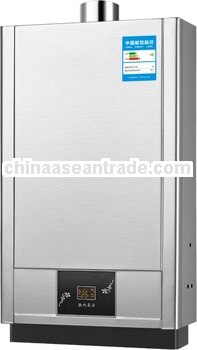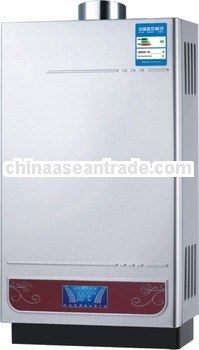Brand:aa
Product detail:
gas water heater
Specification:
| 1.LPG/NG/TG using |
| 2.Low/Zero pressure or normal pressure for startup |
| 3.Range 8L~12L capacity |
| 4.LPG Gas pressure:2800Pa |
| 5.LNG Gas pressure:2000Pa |
| 6.1.5kg~2.2kg Brass heat exchanger |
| 1. forced exhaust type gas water heater | |
| 2.With digital LCD display ( Optional) | |
| 3.Satisfy your different requirements from output water temperature | |
| Constant Gas Water Heater | |
| Product name | forcd exhaust type gas water heater |
| Type of product | Flue Duct type and forced exhausted type are available. |
| Capacity | 8-12L |
| Features | * Low water pressure starup function *anti-wind flow back device,forced exhuast the exhaust outside , thus to protect the indoor from pollution |
| Model | H series | ||
| Capacity(L) Heat input(Kw) | 8/16 | 10/20 | 12/24 |
| gas type & rated gas pressure(pa) | LPG (2800)/NG(2000) | ||
| Product size (mm) | 520*330*140 | 590*340*140 | 620*340*140 |
| packing size(mm) | 600*380*200 | 670*400*200 | 700*430*200 |
| Q'20'/40'/40'HQ | 610/1490 | 520*1260 | 460/1130 |
product structure chart
More Items
More Information of three type of gas water heater:
Difference between Open Flue type, Forced Exhaust type, Constant Temperature type
Open Flue type:
It’s operating principle is: cold water into heater through cold water input, pass filter and water-gas interlock
valve then go into heat exchanger, then output through hot water output after heating. Gas go into gas input,
pass filter, solenoid valve, gas adjustment valve, water-gas interlock valve then into burner.
Gas and the mixture of air in the burner lighted and formed stable flame in the fire hold, and completely
burned in the heat exchanger. The high temperature exhaust gas will go into anti-flow back device and discharge into the air mix with the cold air through the smoke output after passed heat exchanger.
The main feature of open flue type gas water heater is the exhaust gas discharge outside the room through
the exhaust gas pipe, to a certain extent they solve the problem of indoor air pollution. The technology of
Open flue type gas water heater are very mature, price are very low. However, because this type of gas waterheater still need the burning air from indoor,intensity of combustion is very low, the heater size is big, and
some problems of installation and user usage will still cause some unsafe hidder danger. So in the angle of
user safety and environment protection, open flue type will drop out from the market step by step.
Forced exhaust type:
The main reason may cause some safety problem is the air pollution indoor. In order to avoid the CO
poisoning from exhaust gas, Then Fundamental measures is to discharge the exhaust gas outside the door.
Forced exhaust type gas water heater is adopted forced exhaust or forced blast to discharge the exhaust gas outside. Open flue type is adopted exhaust gas pipe to discharge the exhaust gas outside. Open flue type gaswater heater have high demanding for the exhaust gas pipe installation, and it’s hard to satisfy most of the
apartment house in the city. And the safety of forced exhaust type gas water heater are much more perfect,
and easier to install. There are two type of structure of forced exhaust gas water heater: air exhaust type and
forced draft type.
1)Air exhaust type forced exhaust gas water heater
Air exhaust type forced exhaust gas water heater is changer the anti-wind flowback hood into air exhaust
device which included gas exhaust collecting hood, electrical machine, fan, wind pressure switch, in the same
time transform the original control circuit. It’s operating principle: clod water go into cold water input, pass by
filter, water-gas interlock valve, into gas nozzle. Combustion air sucked from indoor by the fan, gas completely
combusted in the combustor, high temperature gas exhaust cooled down by the heat exchanger then into the
fan and forced exhausted outside the door.
2)Forced draft type forced exhaust gas water heater
The structure of forced draft type are very different to air exhaust type. Water pass by filter, water flow switch,
into heat exchanger, water output after heating hot. Gas into water heater, pass by filter, double solenoid
valve, gas adjustment valve then into gas nozzle. Combustion air is sucked into forced draft fan from indoor,
and into sealed combustor after being pressured by the forced draft fan, gas completely combusted in the
combustor, high temperature exhaust gas forced exhausted outside from the exhaust port after cooled down
by the heat exchanger.
The main feature of forced draft type forced exhaust gas water heater is: exhaust gas are forced exhaust
outside, prevent indoor air pollution, ensure our safety; Adopting micro-positive pressure sealed combustor,
forced draft burning type, strengthen burning and heat transfer, which make the thickness of the heating
housing 50% less than the same capacity open flue type gas water heater, and make the large capacity gas
water heater become small size.
Balance type gas water heater:
The current balance type gas water heater are adopted the proportional valve type temperature controlling
theory. There is a water flow sensor cross the pipe of gas water heater. Water flow sensor convert the the water flow into relevant electrical signal, and input to controller. The controller will adjust the gas valve according
to the intensity or frequency of the input signal, making the gas flow and water flow changed proportionally.
Thus to make the temperature of water constant. When the water heater is working, the water flow sensor can sense the water flow and water pressure, then pass the signal into the proportional valve, it will control the the burner(fire row), then will control the firepower and adjust the temperature of water. The water will supplied according to the user’s water temperature setting, and the temperature of the water will not change or just change with a small amplitude.
There are two weakness of forced exhaust type gas water heater. 1, the air that the combustion need is come from indoor. 2. The airflow of water heater can not be adjusted according to the thermal load’s change, making the airflow under low load larger and the use efficiency & maintain thermal efficiency lower, the lowest load
is designed much higher. The balance type gas water heater conquered the above weakness.
The water supply and heating system of balance type are same as forced exhaust type, but the gas exhaust
and combustion system are different. Cold water flow pass filer, water flow sensor into heat exchanger, then
convert into hot water. Gas input pass double solenoid valve,flow adjustment valve into burner. The air that
combustion needed is forced sucked from outdoor by fan. The gas-air mixture lighted in the burner and form
stable flame. The high temperature exhaust gas will be forced exhaust outdoor after cool down by the heat
exchanger. Comparing to the forced exhaust type gas water heater, there are two structure features of
balance type. 1. Sealed combustion system. 2. Sleeve-type(balance type) exhaust pipe.
The structure of the housing is complete sealed, the air that combustion needed suck from outdoor by exhaust pipe, and enter into the housing of gas heater,then forced into the burner by fan, the exhaust gas will be
forced exhausted outdoor by exhaust pipe.
Due to the sealed housing, the combustion system which contains air supply, combustion, heat exchange, gas exhaust makes heater operation isolating the indoor air come true. Thus exhaust gas won’t pollute the indoor air. Balance type gas water heater functionally solve the problem of CO poisoning.
Condensing gas water heater
The main structure difference of condensing gas water and other water heater is the heater
exchanger. In order to fully absorb the heat of high temperature exhaust gas, and conveniently to
collect the condensed water, condensing gas water heater adopts the way of secondary heat exchange.
According to the feature of structure, it can set a condensed heat exchanger above and sensible heat
exchanger below, the condensed collector between them. High temperature exhaust gas successively enter
sensible heat exchanger and condensed heat exchanger from the bottom up.

















 Legal status confirmed
Legal status confirmed

